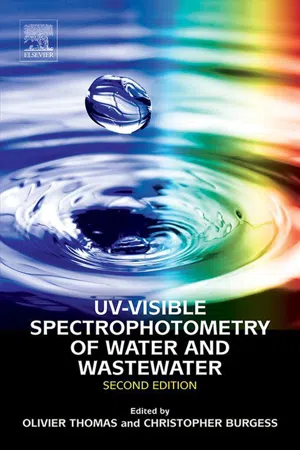
- 538 pages
- English
- ePUB (mobile friendly)
- Available on iOS & Android
UV-Visible Spectrophotometry of Water and Wastewater
About This Book
UV-Visible Spectrophotometry of Water and Wastewater, Second Edition, represents an update to the first book dedicated to the use of UV spectrophotometry for water and wastewater quality monitoring. Using practical examples, the book illustrates how this technique can be a source of new methods of characterization and measurement.
Easy and fast to run, this simple and robust analytical technique must be considered as one of the best ways to obtain a quantitative estimation of specific or aggregate parameters (e.g., Nitrate, TOC) and simultaneously qualitative information on the global composition of water and its variation.
This second edition presents the current methods and applications for water quality monitoring based on UV spectra, including the most recent works and developments. After the introduction of the basics for UV spectrophotometry understanding, the applications of UV measurement are presented, both from the family of chemicals and water quality parameters and from the type of water.
Writing from years of experience in the development and applications of UV systems and from scientific and technical works, the authors provide several useful examples showing the great interest of UV spectrophotometry for water quality monitoring. At the end of the book, the UV spectra library of the first edition is updated with dozens of new chemicals of interest.
- Adds dozens of new chemicals of interest to the first library of UV-spectra dedicated to water, providing data readily available for researchers and users
- Includes new sections on data integrity and security, UV estimation of classes of compounds, UV and turbidity, drinking water, pollution tracking, high frequency monitoring, disinfection by products assessment, pesticides, pharmaceuticals, and more
- Provides a theoretical basis for further research in the field of spectra exploitation
- Contains helpful practical applications of this quick, simple, and inexpensive technique
Frequently asked questions
Information
The Basis for Good Spectrophotometric UV–Visible Measurements
Abstract
Keywords
1.1 Introduction
1.2 Interaction of Light With Matter
1.2.1 The Electromagnetic Spectrum

Table of contents
- Cover image
- Title page
- Table of Contents
- Copyright
- List of Contributors
- Preface to the Second Edition
- Chapter 1. The Basis for Good Spectrophotometric UV–Visible Measurements
- Chapter 2. From Spectra to Qualitative and Quantitative Results
- Chapter 3. Organic Constituents
- Chapter 4. Aggregate Organic Constituents
- Chapter 5. Mineral Constituents
- Chapter 6. Physical and Aggregate Properties
- Chapter 7. Natural Water
- Chapter 8. Drinking Water
- Chapter 9. Urban Wastewater
- Chapter 10. Industrial Wastewater
- Chapter 11. Leachates and Organic Extracts From Solids
- Chapter 12. UV Spectra Library
- Index